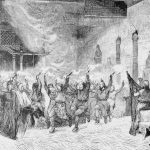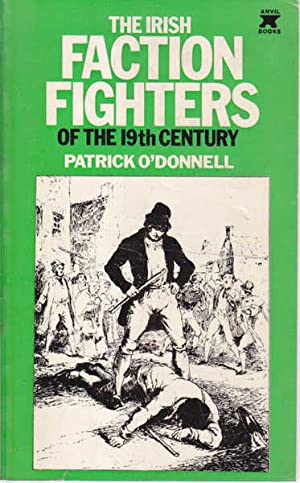How did Scandinavians go from being the most bloodthirsty warriors in European history to the very models of a well-behaved citizenry?

Viking society contained very little in the way of humane prisons, flat-pack furniture or Lego. Drunkenness, extreme violence and hyper-masculinity is what got them their territory, power and wealth.
 A recent reading of Patrick O’Donnell’s hair-raising Irish Faction-Fighters of the 19th Century (Dublin 1975) brought that transformation to mind. Like the Scandinavians, we have plenty of violence in our own past, though, as O’Donnell tells it, we were less goal-directed than the Vikings.
A recent reading of Patrick O’Donnell’s hair-raising Irish Faction-Fighters of the 19th Century (Dublin 1975) brought that transformation to mind. Like the Scandinavians, we have plenty of violence in our own past, though, as O’Donnell tells it, we were less goal-directed than the Vikings.
For about six decades after 1780, a craze for mass public fighting, usually at fairs or markets, swept across Munster and Leinster. In 1827 alone, 1001 “riots” were reported to Dublin Castle. Huge crowds could be involved, with opposing sides sometimes numbering several thousand, all armed with at least a good ash-plant or blackthorn stick, while some also carried guns and knives.
The vast majority of the fights were pre-arranged, and aimed for nothing more than the sheer joy of combat. And they came replete with their own ritual and ceremony. The set-piece taunting was especially rich: “Rams’ horns, rams’ horns, there’s nothing crookeder than rams’ horns” would come from the leader of one side. To which the other would respond: “I know something’ll be crookeder by tonight. Your skull”. The violence was anything but ceremonial, though. At Ballyeagh on the Kerry coast on a single day in June 1834 more than twenty people died and hundreds were seriously wounded.
From such casual ferocity to Ireland’s current doe-eyed docility is just as peculiar a change as the metamorphosis of Vikings into socially responsible feminists. It’s impossible to say precisely what caused these radical transformations, but I think at least two simple ingredients are involved: lots of time and more comfort. Given a few generations and decent central heating, everyone calms down.
But we should never forget just how alien the past can be.
That is absolutely brilliant John, I was wondering that very thing regarding the metamorphosis of Vikings in to modern Scandinavians just a few weeks ago and wondered how that could possibly have happened. Time and comfort do make a great deal of sense, I wondered too about ‘stuff’ ; bonking someone on the head with an iron implement works, fast forward a few millennia and I expect very few would risk the iPhone.
I don’t think we’ve really changed. I learned that when I first saw TV coverage of the Bosnian conflict a few decades ago – pictures of auld fellas with an old rifle, popping over the wall to take a random shot at their neighbor, it could have been in Mayo or Cork. Endless stories of neighbor-against-neighbor. I think the sad story is that we all have extreme violence and hatred within us that will come out in the right circumstances. The better story is that we all have much better things within us too, that can come out…
Please now add a new map to your website ‘Faction Fights 1780-1840 by County and Civil Parish’. Perhaps we might be able to find some leads to deaths in a period where few records currently exist. By the way, my own Co. Clare blackthorn stick was stolen from my car a few weeks ago. It can be recognized easily by the rubber bung on the end which is a slight deviation from the origin 1780 design. A substantial reward is offered to whoever returns it.
Alas, it is out of print. Not in stock at Amazon.
LKlauser – Now I understand why my Irish wife has been kicking my ass for 54 years!
I did full mtDNA to trace my earliest known matrilinear ancestor – a Sarah Rigney (~1800-?) from Borris, Carlow. I expected to find distant Celtic roots, but almost all the known zero genetic distance relationships reported were from 18th and 19th century origin Swedish or Norwegian matrilineal lines. Looking at a map, Borris is a days walk from Wexford or Waterford, both Viking settlements. Most people I know of Irish descendancy who have spit in the bottle have scandinavian DNA reported, but none in their tree, and this seems pretty well researched. Maybe the “Vikes” and the “Micks” are not so genetically different at all. This all begs the question of genetics and temperament. Alcoholism has been found to be hereditary in spite of culture. My exchange son, Torbjørn from Norway, well read on Vikings, told me about the “berserkers” who went ashore first from the raiding long boats. Stoked on amanita muscaria (a common mushroom with hallucinogenic properties) and mead, they did their job of “going berserk” and producing shock and awe effectively. Maybe all the Vikings really needed was the alcohol. Sometimes called “The Irish Virus,” does alcoholism, a trait that was apparently passed down because it was so successful at one time, have a Viking connection? As a retired MD specializing in addiction medicine, I wonder how much alcohol played a part in the riots. Could it be that more money for alcohol and more leisure time for such sport, were available when the Irish populace was so better fed on potatoes in the early 19th century? Was drinking a part of the fighting ritual? Did both the fighting Irish and the berserker Vikings mellow because they somewhat sobered up with changing social norms?
Today getting drunk and fighting is not a successful survival tactic at all.
I believe that Donnybrook Fair and the annual Shoe and bootmaker’s gathering in Bray CoWicklow aka, The Waxie’s Dargle we’re good places for a leathering. Pun intended.
Interesting! The question had never occurred to me before, but my immediate thought while reading the first few lines was: they exported it, of course! Viking means “raider,” and those berserkers went on to plant that belligerent seed across much of Europe, with Ireland getting a healthy dose. The peaceful folks stayed put, and then colonial expansion repeated the process from Europe into the rest of the world. (Ever see Letterkenny, on Hulu? Apparently the “donnybrook” is alive and well in Canada.) The genetics of violence and addiction are, however, somewhat self-limiting, so there’s hope for a continued trend towards peace. (Says the woman with the warrior gene. Who still plays with Lego. 🙂